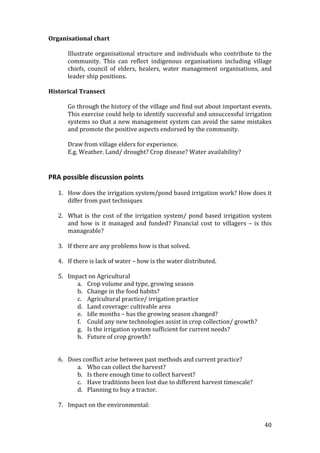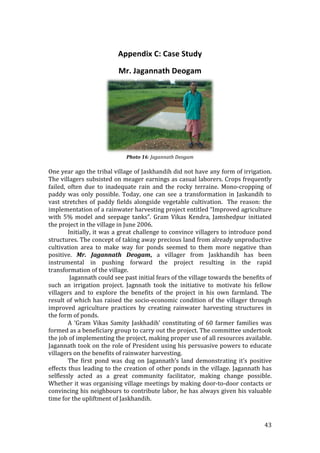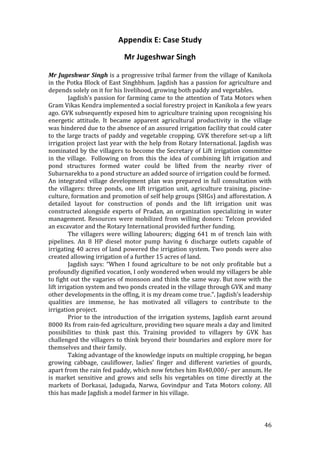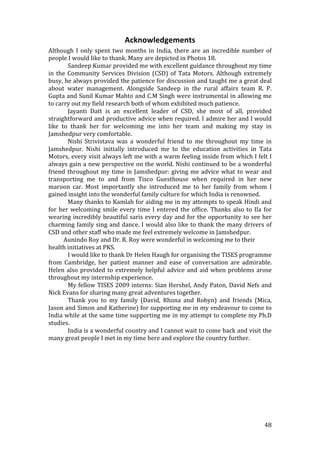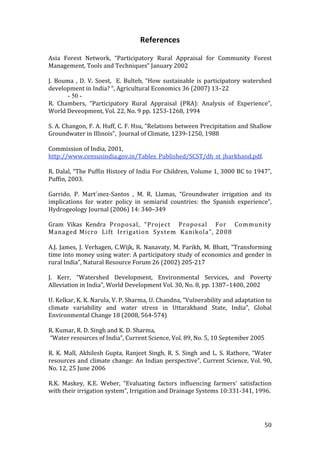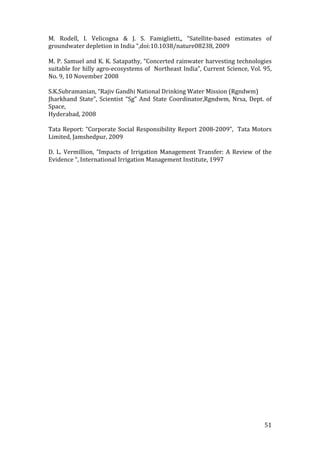This document presents an impact assessment of two water management structures - lift irrigation and rainwater harvesting - in two tribal villages in Jharkhand, India. The study used participatory rural appraisal methods, questionnaires, and interviews to assess the agricultural, environmental, economic, social, and lifestyle changes resulting from these structures. The assessment found that income levels have risen due to higher crop yields and more diverse crops that can be sold. Villagers aim to improve their standard of living through education and diet. While expansion of irrigation is desired, the report cautions against overuse of groundwater.
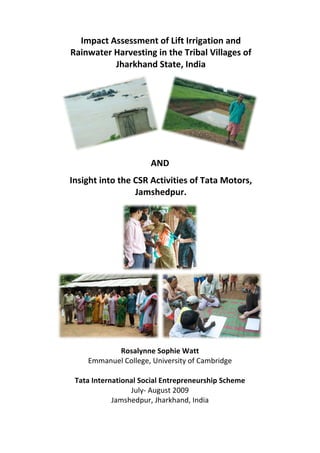




![1
Impact
Assessment
of
Lift
Irrigation
and
Rainwater
Harvesting
in
the
Tribal
Villages
of
Jharkhand
State,
India
1.1 Introduction
Water
scarcity
is
a
huge
problem
for
a
country
such
as
India
[Kelkar,
2008,
James,
2005,
Bouma,
2007,
Kumar,
2007,
Mall,
2006]
which
relies
on
monsoon
weather
for
a
large
majority
of
its
cultivation
practices.
As
weather
patterns
become
increasing
erratic
with
time,
most
likely
due
to
global
warming,
being
prepared
for
water
shortage
in
the
future
is
essential.
Communities
greatly
affected
by
water
scarcity
are
the
tribal
villages
of
Jharkhand
state
[Subramania,
2008].
These
tribal
villages
are
mainly
self‐sustained
in
their
living
habits
and
rely
heavily
on
the
paddy
crop
for
survival
(see
Photo
2
for
a
photograph
of
a
typical
paddy
field).
It
is
becoming
increasingly
difficult
to
maintain
tribal
lifestyle
due
to
the
unknown
weather
patterns
emerging
over
time
and
with
pressure
from
society
to
raise
standard
of
living
in
terms
of
health
and
education
[Kerr,
2002].
It
is
now
well
known
that
when
times
get
tough
for
villagers
there
tends
to
be
migration
from
villages
to
cities
to
seek
employment.
This
can
cause
over‐crowding
in
cities
and
form
a
less
satisfying
environment
in
which
to
live.
It
is
therefore
important
to
maintain
an
acceptable
standard
of
living
in
villages
to
reduce
the
likelihood
of
migration
into
cities.
This
can
be
achieved
by
ensuring
there
are
sufficient
crops
to
feed
villagers
and
to
sell
at
market
to
allow
income
generation.
6](https://image.slidesharecdn.com/reportwattr-120510123629-phpapp01/85/India-Impact-Assessment-of-Lift-Irrigation-and-Rainwater-Harvesting-in-the-Tribal-Villages-of-Jharkhand-State-6-320.jpg)
![Photo
2:
A
typical
paddy
field
in
the
East
Singhbum
district
of
Jharkhand
state.
Irrigation
is
now
essential
in
many
areas
of
the
world
to
harness
sufficient
fresh
water
supply
for
the
successful
growth
of
crops,
in
particular
paddy
which
is
extremely
water
intensive.
In
India,
numerous
forms
of
irrigation
have
been
used
for
centuries
[Vermilliotn,
1997].
Here,
the
impact
of
lift
irrigation
and
rainwater
harvesting
[Samuel,
2008]
in
the
form
of
ponds
which
occupy
5%
of
a
field
are
investigated.
Two
tribal
villages
in
the
Jharkhand
state
of
India
were
chosen
for
the
study:
Konikula
and
Jaskhandih,
on
the
outskirts
of
Jamshedpur
in
the
north
east
of
India.
These
villages
come
under
the
project
area
of
Gram
Vikas
Kendra
(GVK),
the
integrated
rural
development
office
under
the
community
services
division
of
Tata
Motors.
In
both
villages,
the
irrigation
projects
were
initiated
one
year
ago.
The
impact
study
is
therefore
in
its
early
stages,
hence
the
long‐term
benefits
or
failings
of
the
irrigation
systems
can
not,
yet
be
fully
determined.
The
studies
were
carried
out
via
participatory
rural
appraisal
(PRA)
[Chambers,
1994],
questionnaires
and
semi‐structured
interviews
[Maskey,
1996].
The
findings
are
qualitative
and
are
presented
in
terms
of
agricultural,
environmental,
economic,
lifestyle
and
social
impact.
This
section
begins
by
presenting
the
background
information
of
the
villages
under
study
and
an
overview
of
the
irrigation
techniques
employed;
lift
7](https://image.slidesharecdn.com/reportwattr-120510123629-phpapp01/85/India-Impact-Assessment-of-Lift-Irrigation-and-Rainwater-Harvesting-in-the-Tribal-Villages-of-Jharkhand-State-7-320.jpg)
![irrigation
and
5%
pond
structures
for
rain
water
harvesting.
The
methodology
of
the
study
and
results
and
discussion
of
the
impact
study
then
follow.
1.2
Background
Information
1.2.1
Village
Profile
Two
tribal
villages
form
the
main
foci
of
the
study:
Konikula
[Gram
Vikas
Kendra
Proposal]
and
Jaskhandih,.
Another
village,
Dorkasai
is
also
discussed
to
make
comparison
to
a
village
without
an
irrigation
structure.
The
village
of
Dorkasai
is
not
tribal.
The
villages
are
located
in
the
East
Singbhum
district
of
Jharkhand
state
just
slightly
south
east
of
Jamshedpur
as
shown
in
Fig.
1.
The
population
land
statistics
are
presented
in
Table
1.
Kanikola
Jaskandhi
Dorkasai
Figure
1:
Map
of
Jamshedpur
and
surrounding
region.
The
locations
of
Konikula,
Jaskhandih,
and
Dorksai
are
annotated.
(Map
courtesy
of
Google
Maps).
8](https://image.slidesharecdn.com/reportwattr-120510123629-phpapp01/85/India-Impact-Assessment-of-Lift-Irrigation-and-Rainwater-Harvesting-in-the-Tribal-Villages-of-Jharkhand-State-8-320.jpg)
![Parameter
Village
Unit
Konikula
Jaskandih
Dorkasai
Number
of
households
89
215
154
houses
Population
417
1118
804
people
Land
Cultivable
235
400
400
acres
Irrigated
land
235
25
25
Non‐irrigated
land
0
1075
1075
Wasteland
0
700
700
Other
0
0
0
Tribe
or
cast
Santhal
tribe
Ho
tribe
Mahato
cast
Table
1:
Village
statistics
for
the
villages
of
Kanikola,
Jaskhandih,
and
Dorkasai
Traditional
village
or
tribal
lifestyle
dates
back
to
the
Neolithic
revolution,
around
10,000
BC
(i.e.
12,009
years
ago),
when
humans
stopped
a
“hunter
and
gatherer
”
existence
to
begin
cultivation
and
settle
in
one
place
[Roshen,
2003].
Photos
3
show
just
how
unique
tribal
lifestyle
is:
houses
are,
in
general
made
of
mud
sometimes
with
a
thatched
roof
but
most
commonly
with
a
tiled
roof.
Living
facilities
are
basic,
clean
and
tidy.
Villagers
make
their
own
fuel,
Kala
Gola,
by
mixing
mud
and
coal
powder
and
then
leave
it
out
in
the
sun
to
dry.
Their
lifestyle
is
very
in
tune
with
nature,
for
example
mud
utensils
are
used
in
cooking
practices.
The
tribal
communities
are
not
immune
to
advancements
in
technology:
electricity
is
found
in
the
home
alongside
mobile
phones
and
TVs.
Village
schools
are
simple
where
children
of
multiple
stages
are
taught
in
the
same
class.
Some
villages
may
also
have
a
poultry
farm
as
an
industry.
There
are
a
number
of
tribal
denominations
within
India.
Table
1
includes
the
specific
tribes
of
the
villages
in
this
study.
The
total
tribal
population
of
Jharkhand
was
last
counted
to
be
580,1547
[Commission
of
India,
2001].
Kanikola
is
of
the
Santhal
tribes
men
who
form
32.52
%
of
the
total
tribal
population
of
Jharkhand
[Commission
of
India,
2001].
The
Santhali
are
God‐
fearing
and
have
boundless
faith
in
Merghbo
(Mountain)
the
ominescient,
supreme
Santhali
God.
The
most
sacred
centre
of
Santhal
village
is
jakesham
where
the
village
priest
or
the
Nake
Soleminzer
perform
religious
ceremonies.
Farming,
animal
rearing
and
collection
of
minor
forest
produce
are
the
chief
occupations.
9](https://image.slidesharecdn.com/reportwattr-120510123629-phpapp01/85/India-Impact-Assessment-of-Lift-Irrigation-and-Rainwater-Harvesting-in-the-Tribal-Villages-of-Jharkhand-State-9-320.jpg)
![Photos
3:
Photographs
depicting
life
in
a
tribal
village:
Column
1:
Top:
Courtyard
of
a
tribal
village
house.
In
general,
tribal
houses
are
made
of
mud.
Middle:
A
typical
tribal
kitchen.
Bottom:
A
typical
village
bed
called
a
khatia.
Column
2:
Middle:
Kala
Gola
fuel
left
out
to
dry
in
the
sun.
The
fuel
is
made
of
mud
a
coal
powder.
Middle:
Typical
tribal
drums,
mandar.
Column
3:
Top:
A
typical
village
school.
Bottom:
A
village
chicken
farm.
The
villagers
in
Jaskhandih
are
Ho
people.
The
name
“Ho”
evolved
from
the
word
“Horo”
meaning
human.
The
Ho
village
is
ruled
over
by
traditional
administrator
called
“Hatu
Munda”
(village
headman).
The
social
organisation
of
the
community
is
based
on
“Munda‐Maki”
system
that
presides
over
10
to
12
“Hatu
Murdas”.
The
Ho
tribe
was
last
counted
to
make
up
9.24%
of
the
total
tribal
population
of
Jarkhand
[Commission
of
India,
2001].
10](https://image.slidesharecdn.com/reportwattr-120510123629-phpapp01/85/India-Impact-Assessment-of-Lift-Irrigation-and-Rainwater-Harvesting-in-the-Tribal-Villages-of-Jharkhand-State-10-320.jpg)

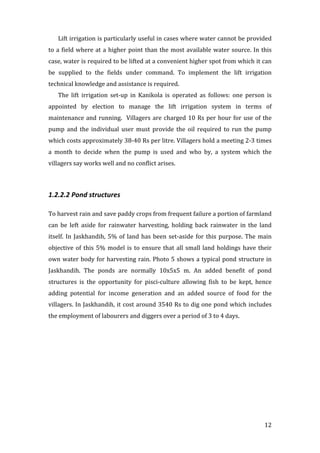
![Photo
5:
A
pond
in
the
village
of
Jaskhandih.
1.3 Methodology
In order to understand the impact of the new irrigation structures in the villages of
Kanikola and Jaskhandih an impact assessment was performed via the following
techniques:
• Semi-structured interviews and questionnaires [Asia
Forest
Network,
2002] were
carried out in both Kanikola and Jaskhandih. The
structured
questionnaire
is
presented
in
Appendix
A
alongside
a
list
of
the
village
beneficiaries
who
participated
in
the
questionnaires.
Following
on
from
the
questionnaires
semi‐structured
interviews
were
carried
out.
Other
beneficiaries
who
participated
in
the
group
discussions
are
also
listed.
In
Kanikola
4
beneficiaries
were
interviewed
and
in
Jaskhandih,
5
beneficiaries
were
interviewed.
If
time
permitted
a
greater
number
of
people
would
have
been
interviewed
to
obtain
more
quantitative
data.
• Participatory rural appraisal (PRA) also provided key information in the study of
the Kanikola. PRA
[Chamber,
1994,
Asia
Forest
Network,
2002] is
a
concept
which
aims
to
provoke
discussion
within
local
communities
to
express,
enhance,
share
and
analyse
knowledge
of
village
life
and
conditions.
The
purpose
of
which
can
be
to
identify
the
needs
and
issues
of
a
community.
In
this
case,
PRA
was
used
to
study
the
impact
of
lift
irrigation
in
the
village
of
Kanikola.
PRA can consist of a variety of exercises including, for example, social
mapping, preference ranking or historical transect. Here semi-structured
13](https://image.slidesharecdn.com/reportwattr-120510123629-phpapp01/85/India-Impact-Assessment-of-Lift-Irrigation-and-Rainwater-Harvesting-in-the-Tribal-Villages-of-Jharkhand-State-13-320.jpg)

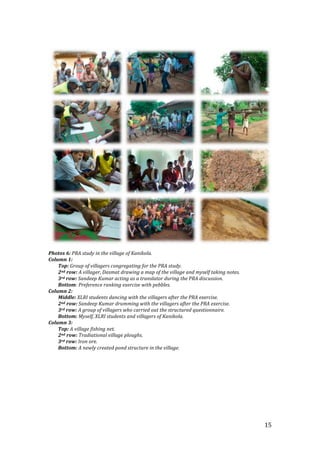

![a)
b)
Figure
2:
Social
and
resource
mapping.
a. Photograph
of
the
social
and
resource
map
of
Kanikola
village
drawn
by
a
villager.
b. Reproduction
of
the
social
and
resource
map.
1.4.2
Preference
Ranking
Preference ranking was performed with respect to food [Asia
Forest
Network,
2002].
This process allowed discussion of the importance of a crop in the village and why
importance may have changed due to the implementation of irrigation. The main
17](https://image.slidesharecdn.com/reportwattr-120510123629-phpapp01/85/India-Impact-Assessment-of-Lift-Irrigation-and-Rainwater-Harvesting-in-the-Tribal-Villages-of-Jharkhand-State-17-320.jpg)



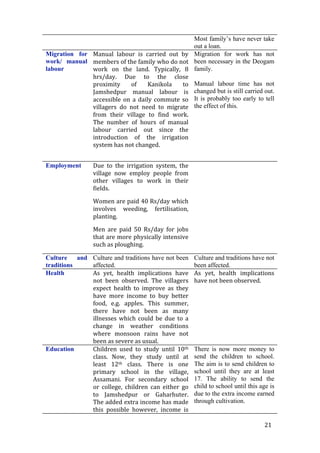
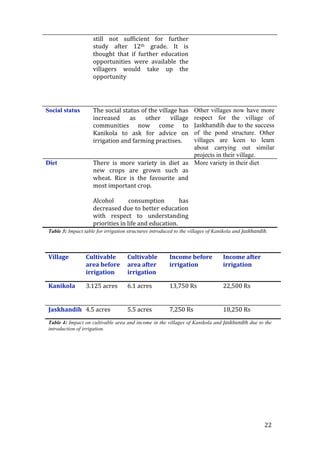


![The
impacts
of
pond
structures
in
Jaskhandih
were
similar
to
the
impact
of
lift
irrigation
in
Kanikola.
Key
to
the
success
of
the
pond
structure
initiatives
is
a
man
called
Mr.
Jagannath
Deogam
(see
Appendix
C)
with
whom
I
had
much
interaction
and
very
much
enjoyed
talking
to.
Jagannath
taught
me
about
his
village
while
at
the
same
time
showed
great
interest
in
my
country
and
held
a
very
open
mind
to
new
ideas.
Jagannath
mentioned
he
would
like
to
change
the
mindset
of
people
in
the
village.
He
believes
that
superstition
should
be
abandoned
for
more
scientific
fundamental
understandings.
For
example,
crops
grow
because
of
water
not
because
of
a
ritual
that
was
carried
out.
It
was
also
apparent
that
many
villagers
are
not
opened
minded
to
introducing
pond
structures
in
the
village
as
it
takes
away
from
cultivation
area.
This
is
slowly
changing
as
people
can
now
see
the
positive
impact
the
pond
structures
have
made
so
far.
In
Jaskhandih
it
seemed
certain
that
the
villagers
aspired
to
spend
their
extra
income
to
educate
their
children.
When
asked:
“What
improvements
can
you
envisage
in
the
current
cultivation
or
irrigation
system?”.
The
villagers
said
they
would
like
to
have
more
vegetable
farming.
This
would
allow
them
to
sell
more
at
market
and
therefore
raise
their
income.
In
Jaskhandih
it
emerged
that
a
hope
for
the
future
would
be
to
have
a
borehole
well
to
access
groundwater
supply.
However,
I
would
advise
against
this
as
it
would
be
environmentally
detrimental
[Changon,
1998,
Garrido,
2006,
Rodell,
2009].
‐It
has
been
observed
globally
that
groundwater
level
is
rapidly
decreasing
with
time
as
it
takes
much
longer
to
replenish
groundwater.
This
would
lead
to
further
lack
of
fresh
drinking
water
for
communities.
It
is
much
better
to
harvest
rainwater
hence
maintaining
top
soil
moisture.
While
speaking
to
the
villagers,
I
found
them
to
be
very
content
people.
The
main
problem
this
year
(2009)
has
been
the
lack
of
monsoon
rain,
however
the
lift
irrigation
and
pond
structures
have
enabled
them
to
keep
paddy
crops
going.
The
villagers
seem
to
have
no
debt
problem
and
have
access
to
manual
labour
in
nearby
Jamshedpur
when
required.
25](https://image.slidesharecdn.com/reportwattr-120510123629-phpapp01/85/India-Impact-Assessment-of-Lift-Irrigation-and-Rainwater-Harvesting-in-the-Tribal-Villages-of-Jharkhand-State-25-320.jpg)


![2
Insight
into
the
Corporate
Social
Responsibility
Activities
of
Tata
Motors,
Jamshedpur
2.1
Introduction
Tata
Motors
undertake
a
variety
of
initiatives
to
support
and
improve
the
communities
in
its
vicinity,
by
promoting
health,
education,
environment
and
economic
self‐sustenance.
In
Jamshedpur,
initiatives
are
also
in
place
to
improve
the
quality
of
life
in
its
adjoining
rural
areas.
The
Community
Services
Division
(CSD)
of
Tata
Motors
consists
of
five
sections
with
the
following
responsibilities.
• Gram
Vikas
Kendra
(GVK):
integrated
rural
development.
The
water
management
project
presented
in
this
report
was
run
under
the
GVK
group.
• Parivar
Kalyan
Sansthan
(PKS):
health
care
• Shiksha
Prasar
Kendra
(SPK):
education
• Nav
Jagrat
Manav
Samaj
(NJMS):
leprosy
A
recently
published
report
[Tata
Report]
describes
the
activities
of
each
in
detail.
Here
I
will
give
a
brief
summary
of
some
activities
followed
by
photographs
depicting
the
many
visits
I
was
privileged
enough
to
make.
Programmes
for
economic
fostering
economic,
social
and
environmental
improvements
of
the
villages
such
as
self‐initiated
cottage
industries,
sericulture,
community
and
social
forestry,
drinking
water
projects,
road
projects,
pulse
polio
drives,
family
planning,
sanitation
projects,
plantation
projects
and
self‐
employed
training
to
name
but
a
few.
CSD
also
supports
other
agencies
such
as
START,
a
centre
of
adult
disabled,
Asha
Kiran
School
and
Mahila
Sharan.
28](https://image.slidesharecdn.com/reportwattr-120510123629-phpapp01/85/India-Impact-Assessment-of-Lift-Irrigation-and-Rainwater-Harvesting-in-the-Tribal-Villages-of-Jharkhand-State-28-320.jpg)








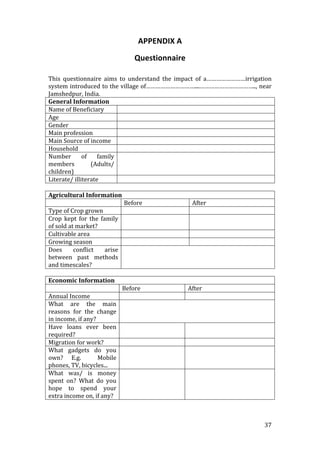
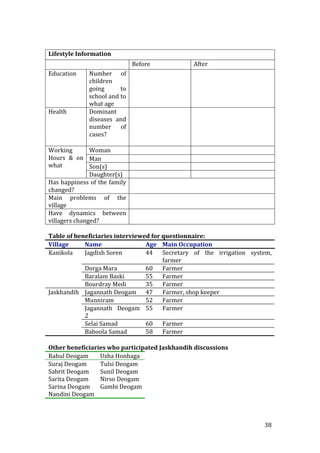
![APPENDIX
B
Participatory
Rural
Appraisal
(PRA)
Exercises
In
this
work
social
and
resource
mapping,
preference
ranking
and
general
discussion
points
were
employed
for
the
PRA
study.
If
time
permitted
other
exercises
would
have
been
employed
such
as
a
seasonal
calendar
and
historical
transect
[Asia
Forest
Network,
2002].
The
PRA
discussion
points
are
only
a
guideline
as
to
what
could
be
discussed
if
the
point
did
not
arise
through
the
initial
exercises.
Exercises
employed
in
this
work:
Social
mapping
This
will
map
out
the
village
giving
information
on
population,
number
of
households.
If
the
village
already
has
a
map
drawn
take
a
picture
and
let
the
villagers
discuss
around
the
map.
See
Table
1:
Village
profile.
Different
castes/
tribes/
income
level
living
on
different
areas
of
the
village.
Resource
Mapping
Map
the
rivers/
anything
and
any
other
natural
resources
important
to
the
village.
Map
where
lowland
/
upland
lies.
Preference
ranking
Preference ranking involves ranking a specific element of society in
importance allowing for discussion and insight into how certain elements of
village lifestyle may have changed.
Other
exercises
which
could
be
employed:
Transect
Walk
Walk
through
village,
what
you
have
seen
on
your
left
and
right.
Seasonal
Calendar/
Time
line
of
a
year:
Go
through
the
growing
seasons
and
describe
the
weather,
what
is
grown
and
what
volume.
Also
find
out
if
there
have
been
any
marked
differences
in
the
growing
season
in
the
past
years
and
what
are
the
reasons.
39](https://image.slidesharecdn.com/reportwattr-120510123629-phpapp01/85/India-Impact-Assessment-of-Lift-Irrigation-and-Rainwater-Harvesting-in-the-Tribal-Villages-of-Jharkhand-State-39-320.jpg)
